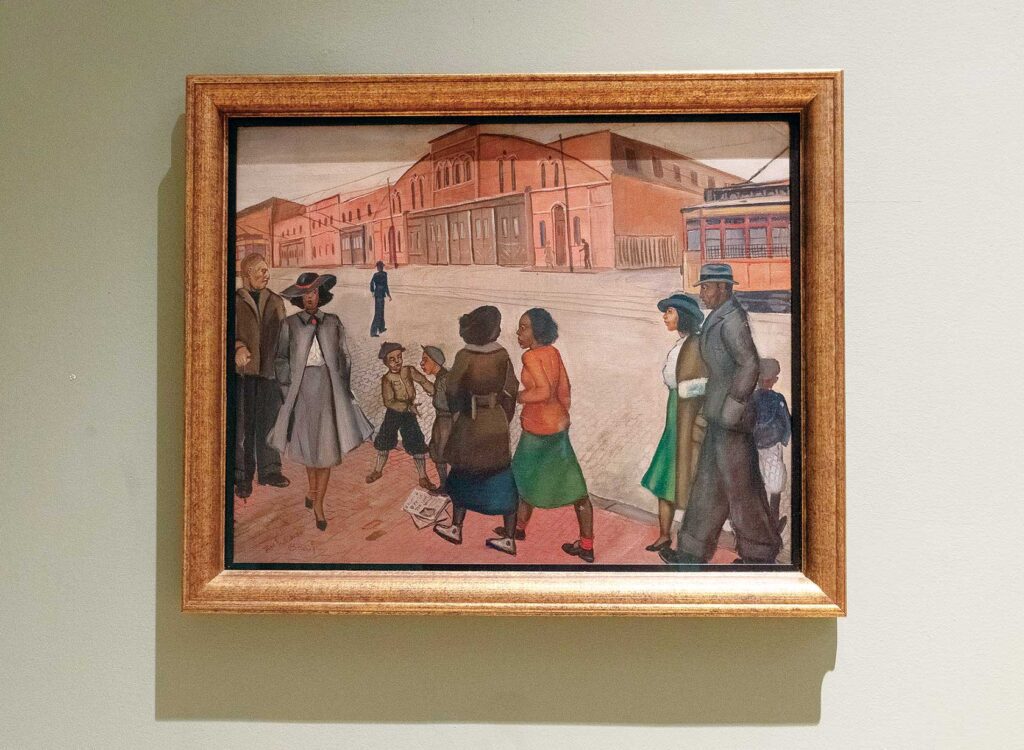Works by Black artists now grace governor’s walls
Part of Healey effort to make State House more inclusive

When guests walk into Gov. Maura Healey’s office in the State House, they will now be greeted by two new paintings by local Black artists.
“I want them to feel seen, represented and empowered. An important way to do this is by hanging artwork that is representative of the diverse Massachusetts experience,” Healey said in a press release announcing the new art.
The hanging of the paintings, on loan from the Museum of Fine Arts, stems from the administration’s goal of hanging more art that reflects the diversity in the Commonwealth. Their addition was announced Dec. 5.
Both of the new images feature communities of color. “Black Tie” by Robert T. Freeman shows a crowd of Black men and women in tuxedos and gowns. The other painting, “At the Tremont Street Car Barns” by Allan Rohan Crite, depicts Black Bostonians in the 1930s in their everyday life.
The effort to make the State House more inclusive is important both to make Massachusetts’ diverse populations feel welcome and to expose people to new viewpoints, said Makeeba McCreary, president of the New Commonwealth Racial Equity and Social Justice Fund.
“[Healey] is deliberately saying, when people come into this building, I want them to look at the walls and see themselves — it’s a simple thing, but it’s pretty powerful,” said McCreary, who helped in the selection process.
Ethan Lasser, MFA’s John Moors Cabot chair of the Art of the Americas Department, said it is a positive that the governor has recognized the role art has to play in a mission of making the State House more inclusive.
“Works of art can be the first invitation, the first point of entry into making your spaces — and in this case, your policies — more inclusive, and will hopefully make people feel more comfortable and also reflect how our city is today,” Lasser said.
Art can help make people feel comfortable in a space, especially if they can identify with the images, said Freeman, who painted “Black Tie.”
“Most of the state houses are filled with portraits of white men, and so it’s a real breath of fresh air to see Black art with Black people in it exhibited at the doorway of the governor,” he said.
McCreary added that seeing only old white men on the walls “doesn’t affirm me or my experience as a Black woman.”
The two works are the start of a broader effort to diversify the State House and its decorations by a governor who has previously expressed a passion for the arts and suggested allocating a record $25 million toward arts and culture in her 2024 budget proposal. McCreary said this is just the beginning of bringing even greater diversity to the walls of the State House.
The two paintings continue an almost-50-year tradition of the MFA loaning works to governors to hang in the executive suite. They join eight other paintings currently on display at the State House and more than 30 total loans. The loans have no specific end date, but State House curator Susan Greendyke Lachevre said are all reviewed annually.
Sharing paintings like these also allows the MFA to get more art in front of more eyes, said Lasser.
“We like getting our collection out and on view, and we’re limited,” he said. “We have a very big building, but our collection is even bigger than the building, so we have them [and] we’re happy to share them for many years.”
Both had been on display previously at the MFA, but weren’t on the walls at the time of the loan.
“When we lent them, they were not on view, but they’re works we’ve shown,” Lasser said. “We’ll miss them, but we also realized that is an important place for them to go as well.”
Greendyke Lachevre, in an email, said the State House Art Commission’s guidelines “strongly recommend” that new art or memorials honor underrepresented communities.
These efforts have played out in requests for loans of artworks as well as the choice of who paints the governor’s portrait. Former governors Jane Swift and Charlie Baker selected female painters Sarah Belchetz-Swenson and Ellen Cooper, respectively. Former governor Deval Patrick chose Simmie Knox, who was the first Black American artist to receive a presidential portrait commission with his image of Bill Clinton.







